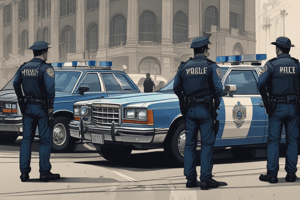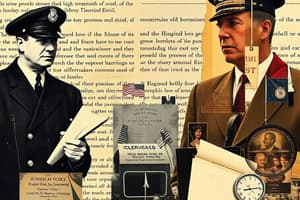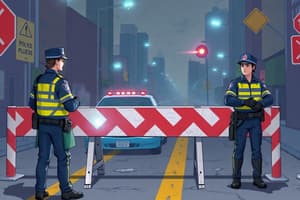Podcast
Questions and Answers
What is the purpose of the written directive mentioned in the content?
What is the purpose of the written directive mentioned in the content?
To establish guidelines and procedures for members of the police department when engaging with individuals participating in First Amendment-protected activities.
What does the First Amendment of the United States Constitution provide individuals and groups?
What does the First Amendment of the United States Constitution provide individuals and groups?
- Right to free education
- Right to organize and participate in assemblies on public ways (correct)
- Right to unlimited property ownership
- Right to drive vehicles on sidewalks
A person commits the offense of rioting if they knowingly assemble with three or more other participants in the assembly.
A person commits the offense of rioting if they knowingly assemble with three or more other participants in the assembly.
False (B)
A buffer zone is a safety zone implemented by __________ and maintained by officers.
A buffer zone is a safety zone implemented by __________ and maintained by officers.
Under what circumstances may the IC designate an active assembly as an unlawful assembly?
Under what circumstances may the IC designate an active assembly as an unlawful assembly?
Kettling is a practice that allows for peaceful protesters to remove themselves from escalating situations.
Kettling is a practice that allows for peaceful protesters to remove themselves from escalating situations.
Who is responsible for evaluating and determining the use of less-lethal weapons in an assembly?
Who is responsible for evaluating and determining the use of less-lethal weapons in an assembly?
Members will make all reasonable efforts to allow law-abiding individuals to continue to exercise their __________ protected rights.
Members will make all reasonable efforts to allow law-abiding individuals to continue to exercise their __________ protected rights.
Match the criteria for giving dispersal orders with their requirements:
Match the criteria for giving dispersal orders with their requirements:
Flashcards are hidden until you start studying
Study Notes
First Amendment-Protected Activities
- The Kansas City Missouri Police Department has established guidelines for members to follow when engaging with individuals participating in First Amendment-protected activities.
- The First Amendment of the United States Constitution provides individuals and groups the right to organize and participate in assemblies, as long as they do not unreasonably obstruct vehicle or pedestrian traffic.
Terminology
- Assembly: A peaceful and lawful gathering or coming together of several individuals, usually for a particular purpose protected by the First Amendment.
- Buffer Zone: A safety zone implemented by command and maintained by officers, designating an area as safe, usually between counter-protesting assemblies.
- Kettling: A tactic used by law enforcement to control crowds, surrounding a group of individuals from all sides, preventing points of egress, sometimes to make arrests or contain individuals.
- Riot: An incident of civil unrest that constitutes a clear and present danger of violent and unlawful acts, such as destruction of property, arson, looting, injury towards persons, or other similar threats/acts.
- Unlawful Assembly: An assembly that has met a specific set of criteria, outlined in RSMo. Section 574.040, that occurs when seven (7) or more participants in the assembly agree to collectively engage in activity with force or violence in violation of state or federal law.
General Guidelines
- First Amendment rights are subject to reasonable time, place, and manner restrictions.
- Members are encouraged to attend and participate in meetings with community stakeholders and assembly sponsors for pre-planned large-scale anticipated assemblies.
- Members will attempt to contact sponsors and organizers of large-scale spontaneous assemblies to establish communication and cooperation.
Procedures
- Small Scale and Peaceful First Amendment Assemblies:
- Members will generally not be involved unless called to respond.
- If called to respond, members will contact a supervisor/commander and assess whether law violations are occurring, and address such violations consistent with their training and duties.
- If no law violations are occurring, members will consult with a supervisor/commander for further direction.
- Large Scale, Protracted and Potentially Unlawful Assemblies:
- A single identifiable incident commander (IC) will be designated by the Chief of Police or their designee.
- The IC will make reasonable efforts to meet with assembly organizers in advance to discuss plans, rules of engagement, and foster a professional and cooperative relationship.
- The IC will continuously evaluate the situation to determine if law enforcement presence is aggravating the situation and make adjustments accordingly.
Unlawful Activities During an Active Assembly
- If an assembly becomes disruptive, commanders will use their best efforts to employ a gradual approach to restore order consistent with the health and safety of the surrounding community.
- If possible, assembly organizers and sponsors, or individuals of leadership roles within the assembly, will be engaged by the IC to communicate expectations and to issue warnings if disruptive activities are not resolved.
Designating an Active Assembly as an Unlawful Assembly
- The IC may designate the active assembly as an unlawful assembly if the criteria for such a designation are met pursuant to RSMo. Section 574.040 and only after reasonable efforts to gain voluntary compliance have failed.
- Dispersal orders will only be given after the IC determines that no less than seven (7) participants in the assembly are collectively engaging in activity with force or violence in violation of state or federal law.
Dispersal Orders and Use of Force
- Clear and unambiguous warnings to disperse will be utilized, and individuals will be given a sufficient and reasonable opportunity to heed the warnings and exit the area.
- The IC or their designee will document the state or federal violation(s) by whatever means are feasible at the time.
- Kettling will only be used when authorized by an IC after concluding that it is reasonable and necessary to protect the public or members from physical harm.
Studying That Suits You
Use AI to generate personalized quizzes and flashcards to suit your learning preferences.




